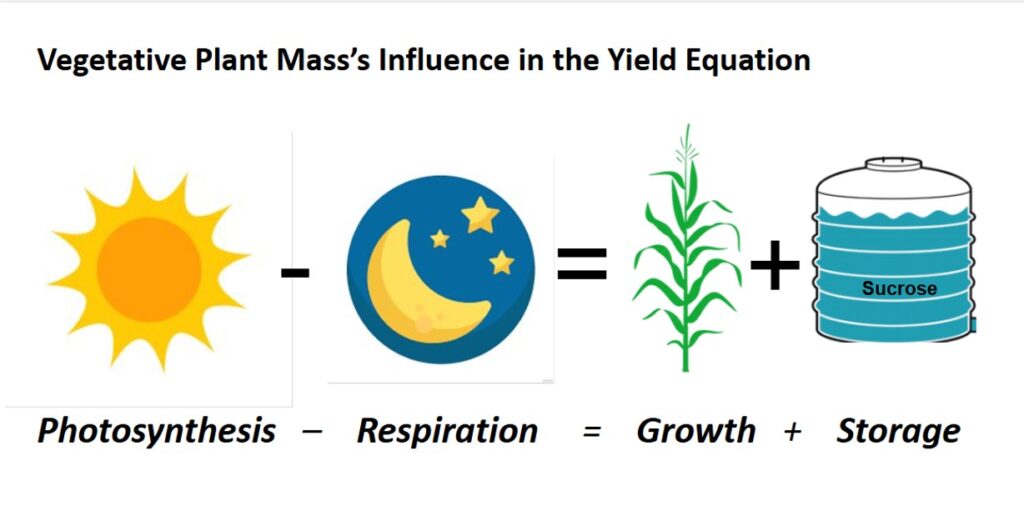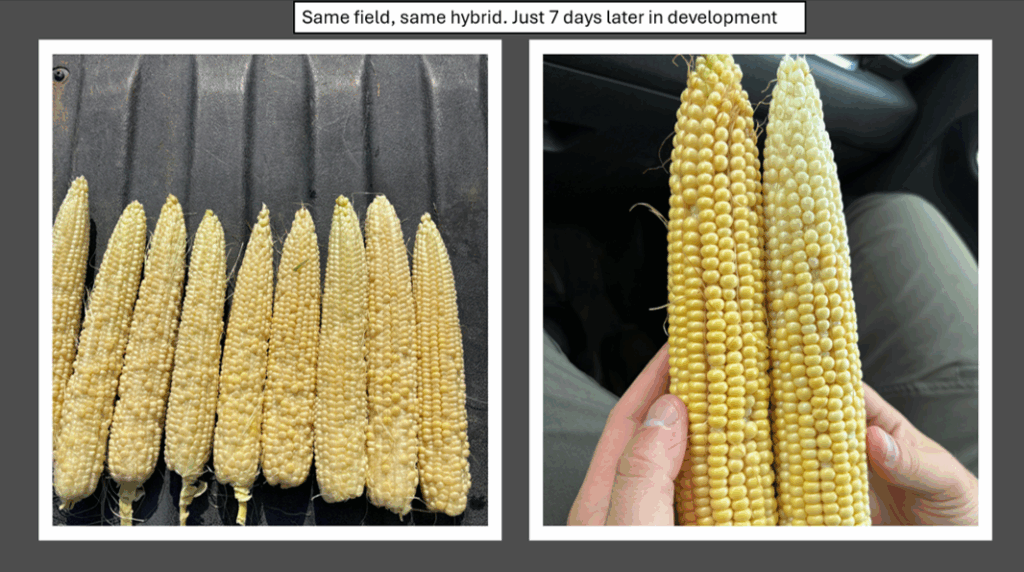From the road, many 2025 corn fields in the Midwest look outstanding. The plants are tall and green, with large leaves. But get out and walk through those fields, and check some ears, and a different story can emerge. Agronomists across the region are finding ears with tip back, signs of kernel abortion, and other clues that the plants have endured stress at critical points this season.
That’s the puzzle facing growers right now: how can a crop that looks so good be quietly losing yield potential?
In recent weeks, many theories have surfaced on social media and in coffee shop conversations. Discussions range from disease pressure to smoke haze to nutrient availability and management issues. The expert agronomists at Advanced Agrilytics recently collaborated on a webinar to discuss what they’re seeing in fields throughout the Midwest, and some of the causes and effects of environmental stressors affecting the 2025 corn crop.
Click Here to Watch the Complete Webinar!
This Year’s Stress Recipe
Based on in-field data and grower reports, our agronomy team identified a mix of biotic (disease, pests) and abiotic (weather, environmental) factors that impacted the crop this year:
- Delayed planting compressed the growing season for many acres.
- Reduced solar radiation: This was linked in part to frequent cloud cover and periods of wildfire smoke. Reduced solar radiation lowers the plant’s photosynthetic potential, limiting the plant’s ability to produce and store energy, in the form of sucrose.
- Extended periods of excess moisture in some regions restricted root growth and nutrient uptake; other areas experienced drought stress.
- High night temperatures increased plants’ respiration rates, burning more of the plant’s stored energy instead of channeling it into growth and stored sucrose, which is essential for a productive grainfill period.
- Foliar diseases such as southern rust, gray leaf spot, and tar spot appeared in pockets, with severity depending on hybrid resistance and effective fungicide protection.
- Insect pressure, particularly aphids in some geographies, caused further plant stress and tip back.
No single factor explains all the issues our agronomists are seeing, but together, these stressors disrupted the corn crop’s development and potential productivity at some point in its development.
Why Sucrose Matters
The underlying concept our agronomists use to explain yield loss this year is simple but powerful:

Photosynthesis – Respiration = Growth + Sucrose Storage
Photosynthesis produces the plant’s energy (in the form of sucrose). The corn plant consumes some of that sucrose for maintenance respiration, and whatever is left supports growth and grainfill. When stress reduces photosynthesis or increases plant respiration, less energy remains for the all-important grainfill.
That’s where R1 sucrose reserves (the sugars stored in the stalk by pollination) become critical. If weather during grainfill turns unfavorable (hot, dry, and/or cloudy), plants with higher sucrose reserves can tap that “fuel tank” to fill kernels. Corn plants with low R1 sucrose content are more likely to experience kernel abortion or reduced kernel size under the same conditions.
Regional Agronomy Lead Dan Emmert compares the sucrose storage capability of a plant to a car’s fuel tank. “If you were going to drive across Death Valley, would you rather be in a vehicle that’s got a 35-gallon fuel tank or a 15-gallon fuel tank?” he asks. “If everything goes perfectly, you may be able to make it with the smaller fuel tank. But if you have stresses, let’s say you get a headwind or use more air conditioning – you’re going to be happy that you had that bigger fuel tank.”
Our in-house research shows that proactive management strategies such as timely fungicide applications can increase R1 sucrose content and improve the crop’s ability to withstand late-season stress.
Stress Timing: The Yield Component Connection
Not all stress affects the corn plant equally. The impact of environmental stressors depends heavily on timing:
- V13–VT: Stress during this period tends to reduce the ear length, resulting in fewer kernels per row.
- VT–R1: Severe stress at tassel through pollination can result in poor pollination or very few kernels being set.
- R2–R3: Stress during blister to milk stage can cause tip back and abortion of kernels, sometimes all the way up and down the ear (“zipper ears”), as the plant reallocates resources.
- R4–R5: Stress during dough to dent stage primarily reduces kernel size and weight due to limited carbohydrate availability during grainfill.

Here’s a clear example of how widely the effects of environmental stressors on corn plants can vary. The ears of corn on the left and right are from the same field, and are the same corn hybrid. The only difference is that the ears on the right were picked seven days after the ears on the left. In the corn ears on the right, you can see where the corn had managed to begin recovering from previous stress and begin to fill kernels.
From Observations to Action
Recognizing the signs of hidden stress is only part of the equation. This season’s observations reinforce several principles:
- Consider Grainfill Management Strategies: Be proactive and talk with your Advanced Agrilytics Precision Agronomist about strategies for how to potentially extend grainfill and positively influence the final yield component in terms of kernel size and weight.
- Be Strategic with Fungicide Decisions: Monitor short-term weather forecasts, disease progression, hybrid disease ratings and projected black layer date to determine if a fungicide re-application is necessary, and how to time it for optimum efficacy. To learn more about this, watch Regional Agronomy Lead Travis Kimmel’s new YouTube video here.
- In-Season Monitoring and Documentation is Crucial: Keeping detailed field notes—planting dates, growth stages at weather events, disease progression—helps connect visual symptoms back to causes.
- Fortify the Crop Proactively: Tools like variable-rate nutrient applications, timely fungicide passes, and managing plant population by environment can help build sucrose reserves and extend grainfill potential.
- Plan for Disease Pressure: Understanding hybrid ratings and local disease trends can guide both hybrid selection and fungicide timing.
- Be Ready to Adjust Harvest Plans: Stalk integrity can be compromised in stressed plants. Monitoring push test results in-season helps prioritize fields most at risk for lodging.
What Growers Can Take Away From 2025
The 2025 corn crop is a reminder that visual health doesn’t always equal yield health. Fields that look green and uniform can still hide damage from stress events earlier in the season.
Yield loss isn’t always dramatic from a single stress event, but layer enough of them together, and the plant’s energy reserves can be drained before the plant hits the finish line. That’s why understanding the crop’s physiological response to environmental stress—and tracking that response through the season—is critical for protecting yield potential.
If you want to learn more about developing strategies for helping your corn crop have a strong finish to the growing season, contact us.
© 2025 Advanced Agrilytics Holdings, LLC. All rights reserved. Advanced Agrilytics and design are trademarks of Advanced Agrilytics Holdings, LLC.